If you want to examine the material in a particular Market, select a market segment using the Market button above. Select Markets to return to Markets page. Other links will take you to other destinations.
Basalt in Construction.
Basalt fibre is a recent addition to the construction and mining markets. The fibre has been used to make a number of specified products for the construction fields. Basalt fibre is substantially lower in cost than carbon fibre but exhibits many of the qualities of carbon fibre in construction.
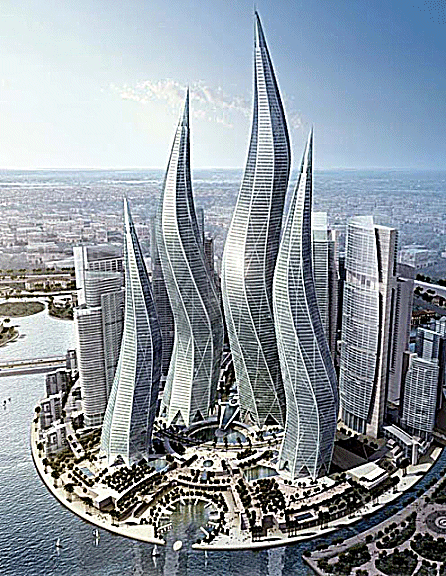 |
Basalt fibre is a material made up of extremely fine fibres of basalt. It is manufactured by melting basalt rocks at high temperatures and processing the fibres in accordance with the needs of the end user. Basalt fibre is used in similar fields to those of carbon fibre and fibreglass, but has far superior physical and mechanical properties when compared to fibreglass. Basalt fibre is much less expensive than carbon fibre, and whilst it cannot fulfil all the demands of carbon fibre, sometimes, the use of carbon fibre is overkill.
Some information about acceptability.
In new construction, for instance, basalt fibre is used to make pultruded reinforcing bars, and externally bonded reinforcing strips. Basalt as a fibre used in FRPs (fibre reinforced polymers) and structural composites. It has qualities such as its high temperature and abrasion resistance, and does not get attacked by either acids or alkalis. Building and construction dominated the global continuous basalt fibre market with around 37% share of the market in 2015.
"ME Construction News" reported: 'In 2015, Gaia Awards winner, Basalt Rock Composite FZE, revealed Basalt Composite Rebar, (BFCR) as an innovative product that can replace steel bars, with basalt, in concrete reinforcing. "The acceptance of the Basalt Composite Rebar will have a tremendous impact on Dubai's construction industry, where steel in concrete was used extensively in almost all projects" Director Bukhash commented. "The world-wide acceptance of these materials will make vast inroads into the construction industry in the foreseeable future." Basalt fibre materials rank high in the fight for environmental improvement. It has a couple of major advantages: The material doesn't corrode, and it is extremely light.
Global Basalt Fiber Market 2015-2020 - Trends and Forecasts for the $200 Million Industry. This headline was used on Jun 04, 2015, by the "Research and Markets Organisation". "Almost 80% of the total basalt fibres demand, in 2014, was from building & construction, automobiles, and wind energy industries. The major reason behind this is basalt fibres are ideally suited for demanding applications requiring high temperatures, chemical resistance, durability, mechanical strength and low water absorption".
The recent spate of regulations, specifications, and reference documents, from such august bodies as the American Concrete Institute (ACI) and ASTM - The American Testing Organisation, reveals that momentum is starting to build in the basalt fibre industry. Five years ago, the material was relatively new internationally, and the construction industry looked askance at the "new boy on the block"! This website has been developed to help industry practitioners gain insights into the very real benefits of basalt fibre technology. (See our reference page on ASTM & ACI specifications).
Our "Products" page on this site show just a few of the brilliant new products that can be employed in the construction, and other industries. However, this specific section is focussed on construction and repair products, so that is where the attention must remain.
There are many aspects to construction, and repair of structural damage. These days, many structures are highly complex, and with the pressure to get everything completed, mistakes can happen. In addition, because of inflation in construction costs, the sooner a structure is brought on line, the sooner the capital input starts to produce a return. Longevity may be the watchword, but with the increase in operational demand, often the design proves inadequate for the task.
Structural repair.
Estimates suggest that over 30% of all bridges in the USA are either structurally deficient, or need replacement. Structural repairs are an important part of the industry, and much of the construction economy it utilised in eking out life beyond the initial designer's brief. Because structural repair has become such a factor, many companies focus their attention on the section of the market that targets prolonging structural life.
When considering the vastness of the repair market , attention is drawn to the main benefits that might be achieved by using basalt fibre materials. Over the years, Portland cement has been ground finer, allowing earlier and higher strengths to be achieved. This has meant that cement quantities could be reduced in concrete mixes. However, higher earlier strength did come at the cost of lower durability. Remember, steel rebar is protected by the highly alkaline environment produced in concrete. Lowering the cement content will affect the longevity of concrete. In earlier times, more cement had to be added to increase the strength achieved in a specific time.
Alongside fast track construction, came higher pollution factors. Some of the pollution had an effect on design principles. It is recognised that chlorides in the environment, are not friendly to steel reinforcement. They lead to steel corrosion. Thicker, heavier structures were built to provide the all-important cover. Today, with fibre reinforcement bars, corrosion is no longer a factor. We don't need 50 mm of concrete cover, placed in position, just there to protect the steel. Unfortunately, for the repair industry, in the future that market is going to hurt.
The Pantheon in Rome
In most cases, experience has shown us that the environment will eventually destroy our structures. How is it possible then, that the old time structures shrug off the ravages of time? The Pantheon in Rome stands 2000 years after it was built, without worries of reinforcement corrosion. Well! the Dome of the Pantheon is unreinforced. So it isn't going to suffer rebar corrosion. And it doesn't have, modern fast-track Portland cement as its binder. Carbonation, and the other nasties of the modern world, leave the Pantheon relatively untouched.
 |
 |
 |
Why those photos?
In the following series of photographs, the effects of pollutants and natural environmental attack on structures are shown. In addition, because we are aware of the effects of the environment, some photographs show the measures designers are taking into consideration.
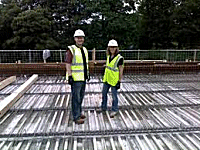 |
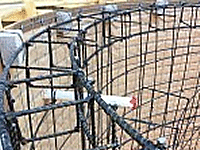 |
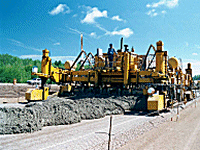 |
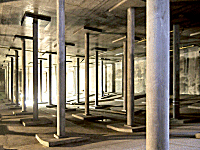 |
Photo 1. It shows a deck in Ireland being prepared for casting. The deck contains basalt rebar. The bridge performance is under constant scrutineering, under the watchful eye of the University in Belfast. Basalt rebar is being used to counter the possibility of corrosion, brought on by de-icing salts. The non-corrosive nature of basalt rebar gives endless resistance to corrosion that would occur if steel was used.
Photo 2. This photo from the Basalt Guru in Newport, Rhode Island, shows the use of basalt rebar in a large swimming pool. Once again, the problem being addressed is reinforcement corrosion. Basalt fibre rebar will never rust, or corrode, giving the owner an asset that will withstand the rigors of time. In addition, because the rebar is not affected by alkali or acid, the reinforcement is unmoved by pool chemicals.
Photo 3. Plastic shrinkage is a factor faced by road and slab constructors. The fibre provides reinforcement to the surfaces whilst the concrete is in its plastic phase. In addition, it provides enhanced durability and improved flexural strength to the pavement.
Photo 4. Water reservoirs can suffer soft water attack. The surface of the cement gets leached away, and gradually the underlying reinforcement starts to corrode. Cleaning off the unsound material, spraying with a layer of shotcrete, embedding basalt fibre mash, and spraying over the mesh to encapsulate it, gives a long term solution.
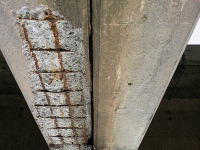 |
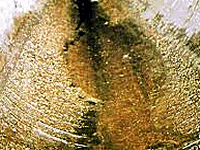 |
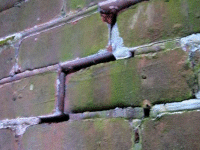 |
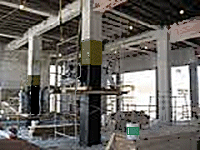 |
Photo 5. The rebar in these beams is under attack. The affected concrete needs to be removed, the steel abrasive blast, or high pressure water jets to remove the rust. Then shotcrete is applied to restore the profiles, adding extra reinforcement can be done with basalt fibre mesh. Refinish the structure, to final levels, with well compacted shotcrete.
Photo 6. All around the world, concrete in sewage works is under attack. Sulphates in the water, and the corrosive nature of the effluent, cause concrete to break down. Removing the affected concrete, cleaning the damaged rebar, replacing necessary steel with basalt reinforcement rods, and shotcreting the areas with fibre mesh reinforcement, gives new life to damaged facilities.
Photo 7. Masonry can be subject to bulging, sagging, cracking and instability. Mortar can shrink and if bricks are not pre-wet, moisture from the plaster is lost into the brick. Without sufficient moisture, the mortar delaminates and shrinks. To save a wall that has cracked like this, rake out the old mortar, push in a small diameter StoneRod rebar to restore stability, and re-grout. You don't have to worry about cover to steel. The rebar will never rust.
Photo 8. Columns receiving additional reinforcement using wrap and an adhesive. Clean and prepare the substrate, patch any spalls, apply primer, if it is required, apply adhesive, and wrap unit in fibre mesh. Once wrap has been applied, use rollers to fully imbed the mesh into the wet adhesive, remove all air pockets or creases. Apply finishing coat of the material used as the fibre binder. Decorate with suitable coating if required.
Of course, thousands of other examples could be given. But, perhaps, it is time to consider the same sort of volcanic improvements to our structures that the Romans used. The Pantheon used lime cement and volcanic ash. Our basalt materials are volcanic rock, which is turned into meaningful improvements for today's structures.
 |
We pride ourselves on our professional service, market knowledge, quality, and most competitive prices.
Return to Top of Page.